FAT TRANSFER BREAST AUGMENTATION
Procedures
Fat Transfer Breast Augmentation in Shreveport, Louisiana
Many women like the idea of enhancing their breast size, but aren’t entirely sold on the aspect of having a foreign substance like silicone or saline in their body. Though breast implants are completely safe for most women, we understand why someone might be hesitant to undergo that procedure. Luckily, there is an alternative. For those seeking a more natural procedure to enhance their breast size, fat transfer breast augmentation is a great alternative.
If you have any questions or would like to know if you would be a good candidate for fat transfer to breasts, schedule a consultation with Dr. Wall today.
Concerned about the cost associated with fat transfer breast augmentation? We can help you find resources and information regarding finances.
What Is Fat Transfer Breast Augmentation?
A fat transfer—or fat grafting—is a procedure that involves transferring fat from one part of the body into another. A breast augmentation is a procedure that changes the size of the breasts, usually by use of silicone or saline implants. Therefore, a fat transfer breast augmentation is seemingly a combination of the two, as fat tissue enhances the breast size via injection.
A fat transfer to breasts is also beneficial for those looking to contour other areas of their body. Because it requires the transfer of fat cells, your surgeon must remove fat from one or multiple areas of your body. The process begins by removing excess fatty tissue through an incision in your abdominal region or other areas where you have unwanted bulges. They may harvest the fat via liposuction from places such as your arms, belly, thighs, lower back, or even your neck or chin.
Will I Have Scars After Breast Augmentation?
A fat transfer breast augmentation is a great option for those who do not want scars. Even though your doctor will work to minimize any potential scarring in any case, augmentation with implants generally leaves a somewhat obvious scar. (Dr. Forrest Wall uses extra precautions to diminish the look of implant scars. Take a look at our before and after breast implant gallery to see.)
Fat grafting uses very small incisions to both suction the fat out of one area and inject the fat into another. These small incision spots leave virtually no scarring, accentuating the natural look you desire.
How Much Does Fat Transfer Breast Augmentation Cost?
Because a fat transfer is essentially two procedures in one, it costs a bit more than a regular breast augmentation might. The price increase accounts for the fact that you’re receiving liposuction that contours certain areas of your body while receiving injections that enhance the breasts. Luckily, the price does not increase too drastically. It may only result in a couple more thousand than you might spend on the average breast implant augmentation. To receive a better price estimate that’s more specific to you, check out our blog How Much is a Boob Job? or call Dr. Wall at 318-221-1629.
How Much Fat is Needed for Fat Transfer Breast Augmentation?
The amount of fat needed for a fat transfer breast augmentation is specific to each person. It generally just depends on how much volume you need for the desired results while still staying within the realm of reason. You also must consider how much excess fat is available. For this reason, women with a low percentage of body fat may not be eligible for a fat transfer breast augmentation procedure. Often, a surgeon will need somewhere between 200 to 500 cc’s of fat, which is enough to increase your breasts by at least one cup size.
Fat Transfer Breast Augmentation: How Long Does it Last?
The procedure itself only lasts a couple hours. You will be put under local anesthesia for the duration of the surgery. Expect the procedure to take about an hour or two, depending on how much tissue they transfer and where they are harvesting it from.
As for the lifespan of the breast augmentation, that is permanent. It is important to remember, though, that a small percentage of the fat transferred into your breasts will likely die a few days post op. Another small percentage will reabsorb back into the body. This goes for any type of fat transfer procedure. Approximately 25-40% of the injected fat won’t survive the transfer, but the remaining 60-75% will settle permanently into your breasts. For this reason, your surgeon may overfill your breasts at first to account for the percentage that will inevitably be lost.
Over the coming weeks following surgery, the newly relocated fat will heal by developing new blood vessels and settling into place. The recovery time ranges between a few days to six weeks. Because this is merely the transfer of natural fat cells, it is important to remember that the cells can change over time. With fluctuations in weight in other regions of your body, your breast size may also fluctuate. This means that if you lose an excess amount of weight, you may notice your breasts decrease in size too.
Fat Transfer Breast Augmentation vs. Implants
Breast augmentation with implants is one of the most common cosmetic procedures.
During this surgical procedure, your surgeon will begin by making an incision under the armpit, around the areola, or underneath the breast. Then, they will create a pocket under the breast tissue to fit in the implant. The implants are essentially silicone shells filled with either saline or silicone gel, both of which have been approved by the FDA. Once placed inside, it will be positioned in a manner that gives the best cosmetic results.
A fat transfer, on the other hand, offers a more natural method for women who seek to increase their breast size. It is favorable for those who do not wish to implant foreign materials like saline or silicone into their body. Because the fat grafting is done with fat cells that are already a part of your body, you won’t be introducing any new substances. Rather, you are simply relocating naturally occurring fat from an undesired area to a more desired area.
Whereas a fat transfer may be more natural, it is also less predictable. You are generally only able to increase your breast size by one cup size. In addition, not all of the transferred fat is guaranteed to stay as it may be reabsorbed into the body. With implants, you can choose an exact size, like going from an A cup to C cup or even up to size D implants if you so desire. That is why those seeking significantly larger breasts may consider implants as opposed to a natural fat transfer.
As you can see, there are pros and cons for both procedures. You and your doctor will discuss all of these in further detail, but the choice is ultimately up to you.
Call Dr. Forrest Wall at the Plastic Surgery Center Today!
Fat transfer breast augmentations are growing in popularity due to the fact that they increase the size of your bust all while naturally contouring the rest of your body. If you’re considering this option, schedule an appointment with Board Certified Plastic Surgeon Dr. Forrest Wall today to see if it’s right for you. Call the Plastic Surgery Center in Shreveport at 318-221-1629 or Monroe at 318-812-0182!

